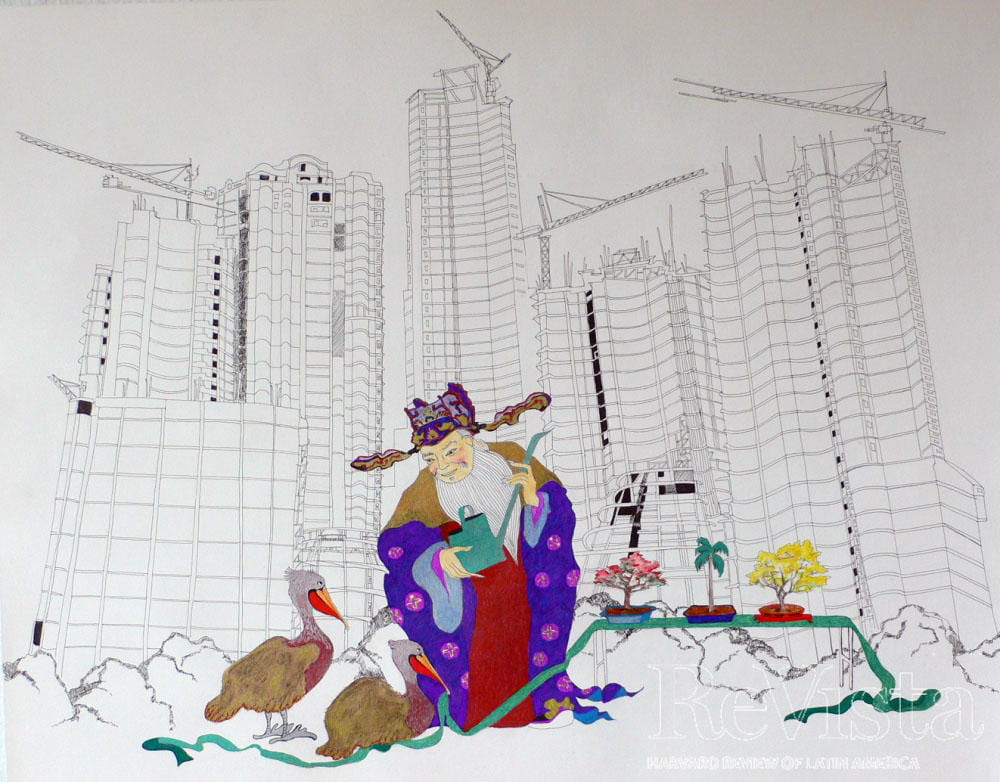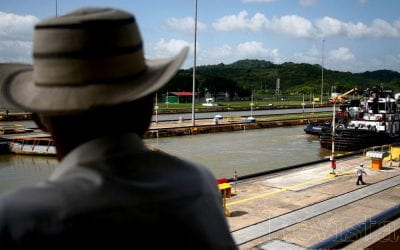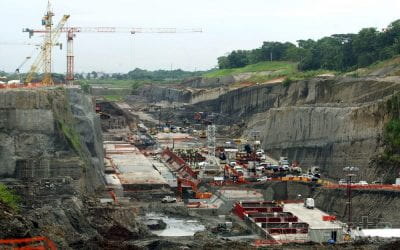Panama City
A Pandora’s Box for Contemporary Art

Pilar Moreno’s Cuentos chinos (2009) is a series of ink-and-watercolors that play with certain aspects of Panama City. Image courtesy of Adrienne Samos.
On May 8, 2003, the Bay of Panamá suddenly turned red. The Coca-Cola factory had spilled a massive amount of non-toxic red chemical dye and was eventually fined $300,000 for its negligence. Before the culprit confessed, some people feared a catastrophe of biblical proportions, while a few others believed it to be an artwork by one of the artists participating in ciudadMULTIPLEcity. The one-month international urban art event curated by Gerardo Mosquera and me had just concluded two weeks before. “The Red Bay was my favorite piece,” someone remarked. Another enthusiastic spectator described it as “a powerful visual metaphor for rampant corruption and political crimes.” The year 2013 marks the tenth anniversary of ciudadMULTIPLEcity, and people still ask me about the inspired author of that work. “The uninvited and unwitting artist was Coke,” I reply.
Although none of the participants of ciudadMULTIPLEcity went as far as changing the color of the ocean, this stupendously mistaken attribution goes to show to what extent our megaproject constituted an exceptional experience in Panamá. We invited twelve artists from abroad (including Francis Alÿs, Ghada Amer, Cildo Meireles, Gu Xiong, Yoan Capote, Jesús Palomino, the collective artway of thinking) and three Panamanians (Gustavo Araujo, Brooke Alfaro, and Humberto Vélez) to create works capable of making a direct impact on the people in the streets. To conceive their works, the foreign artists visited our small but intricate metropolis for a week or two, returning in March 2003 to carry them out. All the works were conceived as hybrid experiments, fusing diverse contemporary genres, such as video, photography, happening, installation, sculpture, painting, performance, conceptual art, participatory art and community work.
The project was inspired by Panama City’s social, cultural and physical character. The city was not merely the site of the event; it was its muse and protagonist. Most of the casual onlookers who came into contact with one or more of the works probably never got to know about the whole project, may not even have felt that they were experiencing art, but that is beside the point. Our challenge was to transcend the art world and engage ordinary citizens, not with mere spectacle or conventional public art, but with experimental artistic practices.
The strategic shape and geographic location of Panamá made it a global city before globalization. It bridged the waters of the world and the lands of the Americas centuries before the canal was built. Gate to the world, our city has become the embodiment of transit and movement. Panama City’s history can be traced back to Panamá Viejo (Old Panamá), the first European capital founded on the American mainland. Built in 1519 and sacked by pirates in 1671, it was rebuilt just a mile further west. Both the ruins of the first city and the historic quarter of the actual city are World Heritage sites. Restricted to the south by the ocean and to the north by the former Canal Zone (until 2000 a U.S. military enclave, a country within another), Panamá was forced to expand along a narrow strip and grow upwards to such an extreme that it has become one of the tallest cities in the world. A huge ethnic and cultural diversity has given it a uniquely rich profile, though its chaotic modernity goes hand in hand with the poverty of most of its people.All of the works in ciudadMULTIPLEcity underwent important changes during their interactions with the city. To me, this malleable, embryonic potential is one of the real measures of significant public art. Take, for instance, Brooke Alfaro’s multimedia performance Nine. The artist worked for over a year with two rival gangs in Barraza, one of the poorest neighborhoods of the city. He persuaded them to interpret a song (each gang separately) by the popular singer and ex-gangster El Roockie; Alfaro then choreographed and filmed them. The two videos were projected side by side on the facade of a building in Barraza, with the community as the main spectator. The crowd’s reaction was intensely moving. It became viscerally evident to all of us—family, neighbors, visitors, and the gang members (who watched the whole show in hiding)—that the work was being charged with new meanings. Alfaro’s intention was to symbolically unite these mortal enemies through art, but the community behaved like the screaming, ecstatic fans of rock stars, precisely because of the performers’ bigger-than-life status as powerful gangsters.
The most significant factor leading to the realization of ciudadMULTIPLEcity was the emerging local art scene. Young artists were already scrutinizing the city and working within conspicuously urban languages that thrive on close encounters with the unpredictable and fractured street life. Many of these artists do not even belong to an artistic tradition; they come from the digital world of computers, of video and photography; others work in advertising, graphic design, architecture, engineering. The vast majority lives in the capital, a deliriously expanding city of services, a communications axis, and a key commercial and banking center. Consequently, the strong demand for technologically savvy professionals has strengthened the local academic offer in these fields, leaving the poor level of art education even farther behind.
Most of these artists—as well as a whole array of students, volunteers, intellectuals and professionals in various fields—actively participated in carrying out ciudadMULTIPLEcity, a truly collective effort that included close to one hundred collaborators. In other words, the event hooked onto a cultural evolution already taking place locally, thus encouraging existing efforts towards a more innovative, critical and socially relevant art.
Although no other experimental urban art project of similar scale and daring has been attempted in Panamá (and rarely elsewhere), a continuous output of artworks motivated by the city’s dynamics keeps emerging, as well as collective urban projects curated by artists, such as Exposed to the Public Eye (2004) and Bus Stop (2009), and remarkable exhibitions, such as the VIII Panama Art Biennial (2008), which focused on the deep social, historical, and urban issues surrounding Panamá’s former Canal Zone, a colonial phantom that still lingers in our collective psyche.
Perhaps no artist has delved into Panama City’s cultural ethos more intensely than Humberto Vélez, particularly about the idiosyncrasies of popular urban classes. Although he has gone far beyond its borders, Panamá still remains at the heart of his research. With La Banda de Mi Hogar, the project he conceived for ciudadMULTIPLEcity—a popular brass-and-percussion band that paraded at the “wrong” times and the “wrong” places— he began to develop a worldwide artistic corpus that he calls “aesthetics of collaboration.” Vélez’s unique participatory performances center on the ways communities relate to their corporal, psychic, and geographical territories by creating their own aesthetics and appropriating public spaces.
Another salient body of work is that of Donna Conlon, an American biologist-turned-artist who decided to make Panamá her home decades ago. No wonder. This concrete emporium, plastered with billboards and besieged by an uncontrolled frenzy of demolition and construction, is spectacularly flanked by nature. One can go in minutes from the urban center to one of the world’s richest areas of biodiversity, and in less than two hours from one ocean to the other. In her video performances, photographs and three-dimensional projects, Conlon highlights the shifting character of beauty and coexistence by working at the threshold where nature and humans relate, and transform, in meaningful ways. Her photographic series titled Synthetic Landscapes captures outlandish but real urban environments: a concrete “peninsula” ensued from industrial waste, green “mountain ridges” of recycled soda bottles, a shimmering “lake” of glass and bottle caps…
Conlon has also co-created many video performances with artist Jonathan Harker, most notably the ongoing (Video) Games series, which show their hands playing uncanny board games by self-made rules symbolizing power struggles between diverse social actors. The chips are made of debris from the myriad construction sites in Panama City, the current victim of fierce speculation that has destroyed much of its architectural heritage.
Equal parts video and conceptual artist, performer, draftsman, photographer, and writer, Harker has gravitated mainly around Panamanian social dynamics in order to expose and subvert conventional wisdom. Other important multimedia artists working within distinctly Panamanian urban poetics include Pilar Moreno, Abner Benaim, Ramón Zafrani, Darién Montañez, and Enrique Castro, as well as photographer José Castrellón, whose portraits and landscapes capture extraordinary personal ways in which a collective sensibility is made manifest.
Artists have always contributed to the understanding and reinvention of the public and cultural life of all cities, not only by exposing disturbing truths and provoking dissent, but also by pointing towards profound, imaginative, unpredictable and exciting new ways of living our shared urban spaces. Panama City is privileged to be the dark muse of incisive creators. However, the real burden of effective social change should not be theirs. This daunting task lies beyond the limits of art and belongs to every one of us.
Spring 2013, Volume XII, Number 3
Adrienne Samos is an independent editor, curator, and art critic based in Panama City. She is director of the arts foundation Arpa and Sarigua Publishers, and advisor for Cisneros-Fontanals Foundation and Endara House Museum.
Related Articles
A Tale of Two Flags
A Tale of Two Flags The Last Hurdle When in 1995 President Ernesto Pérez Balladares appointed me to head the commission responsible for the transition of the Panama Canal from U.S. to Panamanian hands, it never crossed my mind that yet another negotiation—unexpected...
Who Remembers Panamá?
There was a time, many decades ago, when the Isthmian country of Panamá—dividing the Americas—made near daily headlines from Canada to Argentina…
The Story That Panamá Decided to Write
A few days prior to the date set for the transfer of the Panama Canal from the United States to Panamá, a reporter from a U.S. news network asked me, “Mr…




